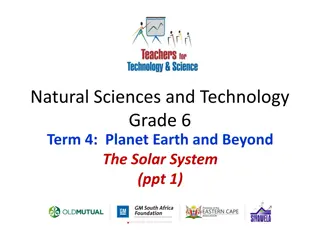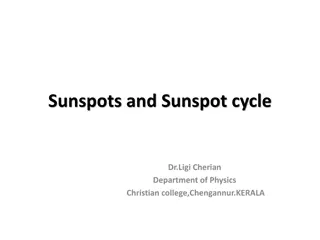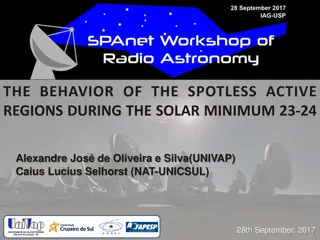Understanding Radio Wave Propagation and Solar Activity Effects
Explore how radio waves travel and are influenced by solar activity. Learn about HF radio wave propagation, critical layers, day-night cycle effects, sunspots, coronal mass ejections, solar wind, auroras, and more. Discover the impacts of solar flux, sunspot numbers, and solar flares on radio wave c
7 views • 45 slides
Space Weather: The Sun-Earth Connection
Explore the intricate relationship between the Sun and Earth, as space weather phenomena such as solar flares and sunspots impact our daily lives. Discover how disruptions in communication systems, satellite navigation, and power grids can occur due to solar activity, highlighting the importance of
5 views • 37 slides
Exploring the Solar System: The Sun and Beyond
Delve into the fascinating world of our Solar System, focusing on the central star, the Sun. Learn about the different celestial bodies and their composition, with a special emphasis on Earth as a planet. Discover the Sun's characteristics, including its size, temperature, and structure. Explore the
0 views • 7 slides
Exploring Sunspots and the Solar Cycle
Sunspots are cooler, darker regions on the solar atmosphere with strong magnetic fields. They are mainly seen on the photosphere, which is the visible surface of the Sun. These dark spots are cooler than their surroundings, with temperatures around 4,000 K. Sunspots are formed due to the Sun's magne
0 views • 31 slides
Understanding HF Propagation and Solar Activity
Explore the basics of HF propagation, how solar activity influences band conditions, and the impact of phenomena like sunspots, flares, and CMEs. Learn which bands to use for effective communication and grasp the fundamentals of wave propagation, refraction, and reflection. This presentation provide
0 views • 30 slides
The Behavior of Spotless Active Regions During Solar Minimum
In this work presented at the SPAnet Workshop on Radio Astronomy in 2017, the study analyzed the physical parameters of spotless active regions observed during the solar minimum period from 2007 to 2010. Radio maps at 17 GHz from the Nobeyama Radioheliograph and magnetograms from the Michelson Doppl
0 views • 14 slides





